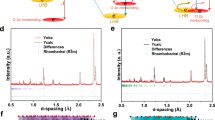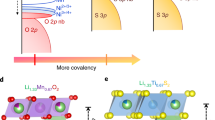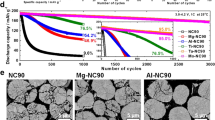Abstract
Li-ion batteries have contributed to the commercial success of portable electronics and may soon dominate the electric transportation market provided that major scientific advances including new materials and concepts are developed. Classical positive electrodes for Li-ion technology operate mainly through an insertion–deinsertion redox process involving cationic species. However, this mechanism is insufficient to account for the high capacities exhibited by the new generation of Li-rich (Li1+xNiyCozMn(1−x−y−z)O2) layered oxides that present unusual Li reactivity. In an attempt to overcome both the inherent composition and the structural complexity of this class of oxides, we have designed structurally related Li2Ru1−ySnyO3 materials that have a single redox cation and exhibit sustainable reversible capacities as high as 230 mA h g−1. Moreover, they present good cycling behaviour with no signs of voltage decay and a small irreversible capacity. We also unambiguously show, on the basis of an arsenal of characterization techniques, that the reactivity of these high-capacity materials towards Li entails cumulative cationic (Mn+→M(n+1)+) and anionic (O2−→O22−) reversible redox processes, owing to the d–s p hybridization associated with a reductive coupling mechanism. Because Li2MO3 is a large family of compounds, this study opens the door to the exploration of a vast number of high-capacity materials.
This is a preview of subscription content, access via your institution
Access options
Subscribe to this journal
Receive 12 print issues and online access
$259.00 per year
only $21.58 per issue
Buy this article
- Purchase on Springer Link
- Instant access to full article PDF
Prices may be subject to local taxes which are calculated during checkout






Similar content being viewed by others
References
Armand, M. & Tarascon, J. M. Building better batteries. Nature 451, 652–657 (2008).
Tarascon, J. M. & Armand, M. Issues and challenges facing rechargeable lithium batteries. Nature 414, 359–367 (2001).
Ohzuku, T. & Makimura, Y. Layered lithium insertion material of LiCo1/3Ni1/3Mn1/3O2 for lithium-ion batteries. Chem. Lett. 30, 642–643 (2001).
Yoshizawa, H. & Ohzuku, T. An application of lithium cobalt nickel manganese oxide to high-power and high-energy density lithium-ion batteries. J. Power Sources 174, 813–817 (2007).
Thackeray, M. M., David, W. I. F., Bruce, P. G. & Goodenough, J. B. Lithium insertion in Manganese spinels. Mater. Res. Bull. 18, 461–472 (1983).
Barpanda, P. et al. A 3.90 V iron-based fluorosulphate material for lithium-ion batteries crystallizing in the triplite structure. Nature Mater. 10, 772–779 (2011).
Padhi, A. K., Nanjundaswamy, K. S. & Goodenough, J. B. Phospho-olivines as positive-electrode materials for rechargeable lithium batteries. J. Electrochem. Soc. 144, 1188–1194 (1997).
Johnson, C. S. et al. The significance of the Li2MnO3 component in ‘composite’ xLi2MnO3 . (1−x)LiMn0.5Ni0.5O2 electrodes. Electrochem. Commun. 6, 1085–1091 (2004).
Johnson, C. S., Li, N. C., Lefief, C., Vaughey, J. T. & Thackeray, M. M. Synthesis, characterization and electrochemistry of lithium battery electrodes: xLi2MnO3. (1−x)LiMn0.333Ni0.333Co0.333O2 (0 < x < 0.7). Chem. Mater. 20, 6095–6106 (2008).
Thackeray, M. M., Johnson, C. S., Vaughey, J. T., Li, N. & Hackney, S. A. Advances in manganese-oxide ‘composite’ electrodes for lithium-ion batteries. J. Mater. Chem. 15, 2257–2267 (2005).
Thackeray, M. M., Kang, S. H., Johnson, C. S., Vaughey, J. T. & Hackney, S. A. Comments on the structural complexity of lithium-rich Li1+xM1−xO2 electrodes (M = Mn,Ni,Co) for lithium batteries. Electrochem. Commun. 8, 1531–1538 (2006).
Hodeau, J. L., Marezio, M., Santoro, A. & Roth, R. S. Neutron profile refinement of the structures of Li2SnO3 and Li2ZrO3 . J. Solid State Chem. 45, 170–179 (1982).
James, A. & Goodenough, J. B. Structure and bonding in lithium ruthenate, Li2RuO3 . J. Solid State Chem. 74, 287–294 (1988).
Armstrong, A. R. et al. Demonstrating oxygen loss and associated structural reorganization in the lithium battery cathode LiNi0.2Li0.2Mn0.6O2 . J. Amer. Chem. Soc. 128, 8694–8698 (2006).
Koga, H. et al. Reversible oxygen participation to the redox processes revealed for Li1.20Mn0.54Co0.13Ni0.13O2 . J. Electrochem. Soc. 160, A786–A792 (2013).
Koga, H. et al. Different oxygen redox participation for bulk and surface: A possible global explanation for the cycling mechanism of Li1.20Mn0.54Co0.13Ni0.13O2 . J. Power Sources 236, 250–258 (2013).
Sathiya, M. et al. High performance Li2Ru1−yMnyO3 (0.2 < y < 0.8) cathode materials for rechargeable lithium-ion batteries: Their understanding. Chem. Mater. 25, 1121–1131 (2013).
Xiao, R. J., Li, H. & Chen, L. Q. Density functional investigation on Li2MnO3 . Chem. Mater. 24, 4242–4251 (2012).
Mori, D. et al. Synthesis, phase relation and electrical and electrochemical properties of ruthenium-substituted Li2MnO3 as a novel cathode material. J. Power Sources 196, 6934–6938 (2011).
Tarakina, N. V. et al. Investigation of stacking disorder in Li2SnO3 . Z. Kristall. 375–380 (2009).
Shannon, R. D. Revised effective ionic-radii and systematic studies of interatomic distances in halides and chalcogenides. Acta Crystallogr. Sec. A 32, 751–767 (1976).
Kobayashi, H., Kanno, R., Kawamoto, Y., Tabuchi, M. & Nakamura, O. Physical properties of the de-lithiated Li2−xRuO3 with the layered structure. Solid State Ion. 86-8, 859–863 (1996).
Teo, L. P., Buraidah, M. H., Nor, A. F. M. & Majid, S. R. Conductivity and dielectric studies of Li2SnO3 . Ionics 18, 655–665 (2012).
Park, S. H., Sato, Y., Kim, J. K. & Lee, Y. S. Powder property and electrochemical characterization of Li2MnO3 material. Mater. Chem. Phys. 102, 225–230 (2007).
Gu, M. et al. Formation of the spinel phase in the layered composite cathode used in Li-ion batteries. ACS Nano 7, 760–767 (2013).
Selwyn, L. S., McKinnon, W. R., Dahn, J. R. & Lepage, Y. Local environment of Li intercalated in Mo6SezS8−Z as probed using electrochemical methods. Phys. Rev. B 33, 6405–6414 (1986).
Yabuuchi, N., Yoshii, K., Myung, S. T., Nakai, I. & Komaba, S. Detailed studies of a high-capacity electrode material for rechargeable batteries, Li2MnO3–LiCo1/3Ni1/3Mn1/3O2 . J. Amer. Chem. Soc. 133, 4404–4419 (2011).
Dulac, J. Spinel compounds between ruthenium oxide RuO2 and some Transition Metal oxides. Bull. Soc. Fr. Mineral. Cr. 92, 487–488 (1969).
Nozik, A. J. Optical and electrical properties of Cd2SnO4—A defect semiconductor. Phys. Rev. B 6, 453–459 (1972).
Singh, P. et al. Electronic structure, electrical and dielectric properties of BaSnO3 below 300 K. Jpn. J. Appl. Phys. 47, 3540–3545 (2008).
Mouyane, M., Womes, M., Jumas, J. C., Olivier-Fourcade, J. & Lippens, P. E. Original electrochemical mechanisms of CaSnO3 and CaSnSiO5 as anode materials for Li-ion batteries. J. Solid State Chem. 184, 2877–2886 (2011).
Manju, U., Awana, V. P. S., Kishan, H. & Sarma, D. D. X-ray photoelectron spectroscopy of superconducting RuSr2Eu1.5Ce0.5Cu2O10 and nonsuperconducting RuSr2EuCeCu2O10 . Phys. Rev. B 74, 245106 (2006).
Lu, M. F., Deng, X. L., Waerenborgh, J. C., Wu, X. J. & Meng, J. Redox chemistry and magnetism of LaSrM0.5Ru0.5O4+/−δ (M = Co, Ni and Zn) Ruddlesden–Popper phases. Dalton Trans. 41, 11507–11518 (2012).
Dupin, J. C., Gonbeau, D., Vinatier, P. & Levasseur, A. Systematic XPS studies of metal oxides, hydroxides and peroxides. Phys. Chem. Chem. Phys. 2, 1319–1324 (2000).
Fukuzumi, S. & Ohkubo, K. Quantitative evaluation of Lewis acidity of metal ions derived from the g values of ESR spectra of superoxide: Metal ion complexes in relation to the promoting effects in electron transfer reactions. Chem.-Eur. J. 6, 4532–4535 (2000).
Rouxel, J. The importance of anions in redox-type chimie douce. Mol. Cryst. Liq. Cryst. Sci. Technol. Sect. A 310, 1–4 (1998).
Rouxel, J. Anion–cation redox competition and the formation of new compounds in highly covalent systems. Chem.-Eur. J. 2, 1053–1059 (1996).
Rouxel, J. Design and chemical reactivity of low dimensional solids—some soft chemistry routes to new solids. Acs Symp. Ser. 499, 88–113 (1992).
Bichat, M. P. et al. Redox-induced structural change in anode materials based on tetrahedral (MPn4)x− transition metal pnictides. Chem. Mater. 16, 1002–1013 (2004).
Ceder, G. et al. Identification of cathode materials for lithium batteries guided by first-principles calculations. Nature 392, 694–696 (1998).
Tarascon, J. M. et al. In situ structural and electrochemical study of Ni1−xCoxO2 metastable oxides prepared by soft chemistry. J. Solid State Chem. 147, 410–420 (1999).
Graetz, J., Ahn, C. C., Yazami, R. & Fultz, B. An electron energy-loss spectrometry study of charge compensation in LiNi0.8Co0.2O2 . J. Phys. Chem. B 107, 2887–2891 (2003).
Li, H., Wang, Z., Chen, L. & Huang, X. Research on advanced materials for Li-ion batteries. Adv. Mater. 21, 4593–4607 (2009).
Zvereva, E. A. et al. A new layered triangular antiferromagnet Li4FeSbO6: Spin order, field-induced transitions and anomalous critical behavior. Dalton Trans. 42, 1550–1566 (2013).
Rodriguez-Carvajal, J. Recent advances in magnetic-structure determination by neutron powder diffraction. Physica B 192, 55–69 (1993).
Doyle, M., Newman, J. & Reimers, J. A quick method of measuring the capacity versus discharge rate for a dual lithium-ion insertion cell undergoing cycling. J. Power Sour. 52, 211–216 (1994).
Cava, R. J. Schizophrenic electrons in ruthenium-based oxides. Dalton Trans. 2979–2987 (2004).
Kresse, G. & Furthmuller, J. Efficient iterative schemes for ab initio total-energy calculations using a plane-wave basis set. Phys. Rev. B 54, 11169–11186 (1996).
Perdew, J. P., Burke, K. & Ernzerhof, M. Generalized gradient approximation made simple. Phys. Rev. Lett. 77, 3865–3868 (1996).
Dedryvere, R. et al. Electrode/electrolyte interface reactivity in high-voltage spinel LiMn1.6Ni0.4O4/Li4Ti5O12 lithium-ion battery. J. Phys. Chem. C 114, 10999–11008 (2010).
Acknowledgements
We thank E. Clot (ICG) and O. Eisenstein (ICG) for helpful discussions about the reductive elimination mechanism, Y. Klein (IMPMC) for discussions about Ru oxides and J-N. Chotard (LRCS) for discussions about crystal structures and X-ray diffraction.
Author information
Authors and Affiliations
Contributions
M.S., K.R., C.P.L. and A.S.P. carried out the synthesis, M.S. and J-M.T. conducted the electrochemical work and J-M.T. designed the research approach; G.R. analysed the crystal structures and diffraction patterns; H.V. collected and analysed the EPR spectra; M.T.S. collected and analysed the Mössbauer data; D.F. and D.G. collected and analysed the XPS spectra; W.W. performed the pressure cell experiments: M.B.H. and L.D. carried out the TEM studies: M-L.D. conducted the DFT calculations and developed the theoretical framework; M-L.D., G.R. and J-M.T. wrote the manuscript and all authors discussed the experiments and final manuscript.
Corresponding author
Ethics declarations
Competing interests
The authors declare no competing financial interests.
Supplementary information
Supplementary Information
Supplementary Information (PDF 1474 kb)
Rights and permissions
About this article
Cite this article
Sathiya, M., Rousse, G., Ramesha, K. et al. Reversible anionic redox chemistry in high-capacity layered-oxide electrodes. Nature Mater 12, 827–835 (2013). https://doi.org/10.1038/nmat3699
Received:
Accepted:
Published:
Issue Date:
DOI: https://doi.org/10.1038/nmat3699
This article is cited by
-
Structurally robust lithium-rich layered oxides for high-energy and long-lasting cathodes
Nature Communications (2024)
-
Mn-based cathode materials for rechargeable batteries
Science China Chemistry (2024)
-
Design Strategies for Aqueous Zinc Metal Batteries with High Zinc Utilization: From Metal Anodes to Anode-Free Structures
Nano-Micro Letters (2024)
-
Decoupling the roles of Ni and Co in anionic redox activity of Li-rich NMC cathodes
Nature Materials (2023)
-
Delocalized electron holes on oxygen in a battery cathode
Nature Energy (2023)



